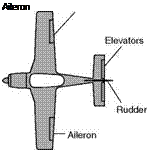Control of an aeroplane
Where an aeroplane is stable or unstable, it is necessary for the pilot to be able to control it, so that he can manoeuvre it into any desired position.
Longitudinal control is provided by the elevators, i. e. flaps hinged behind the tail plane, or movement of the whole tail plane.
Roll control is provided by the ailerons, i. e. flaps hinged at the rear of the aerofoils near each wing tip.
Directional control is provided by the rudder, i. e. a vertical flap hinged to the stern post.
The system of control is the same in each case, i. e. if the control surface is moved it will, in effect, alter the angle of attack and the camber of the complete surface, and therefore change the force upon it (see Fig. 9.12, overleaf). On many aircraft the roll can also be controlled by the use of spoilers. These are described in more detail later.
The elevators and ailerons are controlled by movements of a control column on which is mounted a handwheel which is usually abbreviated to something rather like a car steering wheel with most of the rim sawn off to leave a pair of small handgrips or ‘spectacles’.
Pushing the control column forward lowers the elevators, thus increasing the lift on the tailplane and making the nose of the aircraft drop. Turning the handwheel anti-clockwise lowers the right hand aileron and raises the left, thus rolling the aircraft left-wing down.
In old aircraft and aircraft such as fighter aircraft, where cockpit room is restricted, there is no handwheel and instead the control column moves to left and right as well as backwards and forwards – the left-hand movement is equivalent to turning the handwheel anti-clockwise (left hand down). A small version of this type of ‘joystick’ control is now used on many aircraft. It resembles the kind of control stick used for model aircraft and computer games. It is placed to one side of the pilot, and consequently referred to as a side-stick.
 |
 |
Fig 9.12 Control surfaces
The use of such a small control device is possible because the flight controls are fully power operated, and require no physical force from the pilot.
The rudder is controlled by foot pedals. Pushing the left pedal forward deflects the rudder to the left and therefore turns the nose of the aircraft to the left. This can cause some problems amongst learner pilots as the movement is opposite to that of bicycle handlebars.
In each instance it will be noticed that the control surfaces are placed as far as possible away from the centre of gravity so as to provide sufficient leverage to alter the position of the aeroplane.
On modern aircraft there may also be a secondary set of inboard ailerons which are used in high speed flight where the outboard surfaces could produce excessively large rolling moments, or unacceptable structural loading or wing twist.












